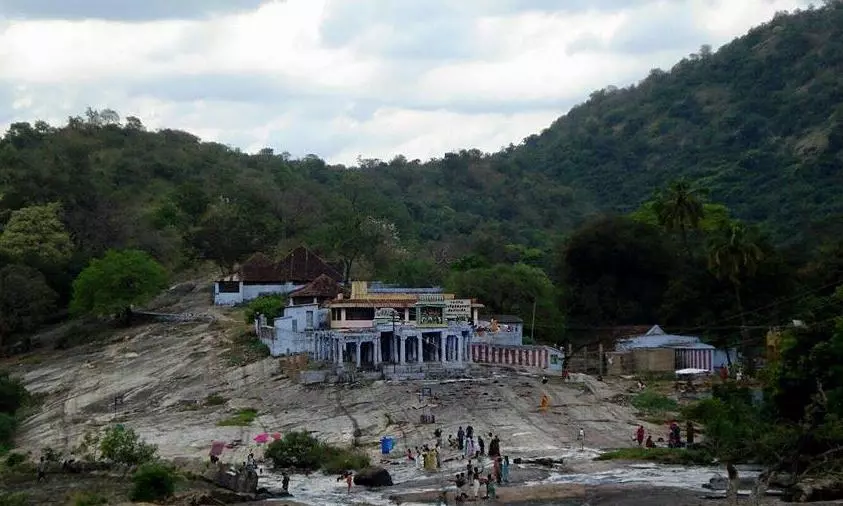
South floods push TN to kickstart intra-state river-linking project
TN govt conducts trial run of Thamirabarani-Kanrumeniyar-Nambiyar river-linking project that will address water needs of Tirunelveli, Thootthukudi districts

The unprecedented torrential rains that hit Tamil Nadu's Tirunelveli and Thoothukudi districts wreaked havoc and destruction last week. A silver lining has now emerged.
The two are arid districts are always in quest of potable water, and the recent rains have given an impetus to Tamil Nadu's first-ever intra-state river-linking project. After heavy rains lashed these southern districts, many rivers and waterfalls started to overflow, pushing the Tamil Nadu government on December 17 to carry out a trial run run of the Thamirabarani-Kanrumeniyar-Nambiyar intra-state river-linking project. This was done by releasing the surplus water from the Thambirabarani into the canals dug as part of the project.
This project, which is yet to be completed, will help to meet the dire water needs of the southern regions and also irrigate close to 56,000 acres of farm lands.
A statement issued by the government said the river-linking project, announced by the late Tamil Nadu Chief Minister M Karunanidhi in 2008, will carry 2,765 mcft surplus water from the Thamirabarani to rain-fed areas of Palayamkottai, Nanguneri and Radhapuram constituencies in Tirunelveli district and to Thiruvaikundam and Tiruchendur constituencies in Thoothukudi district.
The statement further said:added, “The project was given a go ahead in four phases on February 21, 2009. In the past two years, three phases were completed and the last phase is in the home stretch. The canals have been built for about 75.2 km length (67.1 km in Tirunelveli and 8.10 km in Thoothukudi) under this project."
Interlinking of intra-state rivers
It may be recalled that during the 53rd National Development Council meeting in New Delhi on May 29, 2007, a resolution was adopted which said if consensus cannot be arrived at for linking inter-state rivers, the Union should come forward to support the interconnection of intra-state rivers by providing financial assistance.
"Linking of intra-state rivers can be the fitting solution to shortage of irrigation water," the late Karunanidhi had said in the meeting. Subsequently, during the 54th National Development Council (NDC) meeting on December 19, 2007, he appealed to the Union government to allot funds for such projects within states. This was again stressed by Public Works Department Minister Duraimurugan in the next meeting.
Acting on the appeals, the NDC gave its nod to fund intra-state river linking projects under the accelerated irrigation assistance scheme.
Tamil Nadu takes the first initiative
"Tamil Nadu, which took the initiative in this direction, started work on interlinking the Cauvery and the Gundar rivers on June 24, 2008. As the Cauvery dispute still remains unresolved, the work on connecting the Thamirabarani-Karumeniyar-Nambiyar rivers has been taken up now to fulfil our demand," said Karunanidhi during the launch of this river linking project.
He inaugurated the project from the hospital bed of Sri Ramachandra Medical College Hospital and Research Institute, Chennai where he was undergoing a spine surgery. At that time, the Cauvery-Gundar river linking project was touted as the state's first intra-state river linking initiative, however, it had got delayed due to land acquisition related issues.
Meanwhile, the TN government has brought the Thamirabarani-Kanrumeniyar-Nambiyar river-linking project to life by conducting a trial run releasing water from its canals. If this turns out to be successful, it will go down as the first-ever intra-state river linking project in Tamil Nadu.
The project timeline
The Thamirabarani-Karumeniyar-Nambiyar river linking project commenced with a cost estimate of ₹369 crore. The project aimed to undertake various development works including the construction of a flood bank in the Kannadian channel located across the Thamirabarani.
The project also envisioned the formation of a flood carrier canal of about 73 km length, from Kannadian channel to drought prone areas of Thisayanvilai (Tirunelveli) and Sathankulam (Thoothukudi). The project was expected to be completed in three years between 2009 and 2011. However, the then DMK government could only complete building a 40 km long canal.
Following the regime change in 2011, the AIADMK government continued work on the project albeit in a lackadaisical manner.
A reply to an RTI (Right to Information) query filed by M Appavu, the current Speaker, who was then an MLA, revealed that the AIADMK government allocated ₹100 crore in 2012-13, ₹156 crore in 2013-14 and ₹119 crore in 2014-15, for the third and fourth phase of the project. However, the Public Works Department spent only ₹24.8 crore and returned the remaining amount to the state government.
Once the final phase is completed, the project will benefit 32 villages, 177 ponds in Tirunelveli and 18 villages, 75 ponds in Thoothukudi.
Environmental impact
The project is not without its share of environmental concerns. Talking to The Federal, M Mathivanan, senior research associate and coordinator, Ashoka Trust for Research in Ecology and the Environment (ATREE) – Agasthyamalai Community Conservation Centre (ACCC) in Tirunelveli, said intra-state river linking projects are bound to impact the environment.
"With regard to this particular river linking project, while on the one hand it can recharge groundwater aquifers, on the other hand, there is a possibility that people who are carrying out farming activities in dryland cultivation will shift to wetland cultivation and start cultivating water-intensive crops. This change in cropping pattern will affect the ecosystem in these dryland regions," he pointed out.

